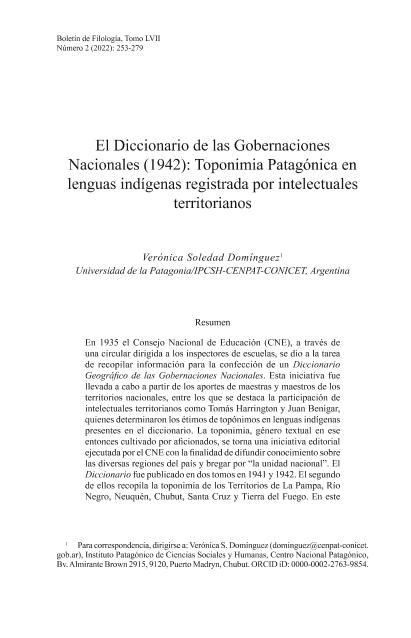Artículo
En 1935 el Consejo Nacional de Educación (CNE), a través de una circular dirigida a los inspectores de escuelas, se dio a la tarea de recopilar información para la confección de un Diccionario Geográfico de las Gobernaciones Nacionales. Esta iniciativa fue llevada a cabo a partir de los aportes de maestras y maestros de los territorios nacionales, entre los que se destaca la participación de intelectuales territorianos como Tomás Harrington y Juan Benigar, quienes determinaron los étimos de topónimos en lenguas indígenas presentes en el diccionario. La toponimia, género textual en ese entonces cultivado por aficionados, se torna una iniciativa editorial ejecutada por el CNE con la finalidad de difundir conocimiento sobre las diversas regiones del país y bregar por “la unidad nacional”. El Diccionario fue publicado en dos tomos en 1941 y 1942. El segundo de ellos recopila la toponimia de los Territorios de La Pampa, Río Negro, Neuquén, Chubut, Santa Cruz y Tierra del Fuego. En este artículo nos proponemos describir la fuente y su configuración, analizar el rol del CNE y de las redes de maestros que colaboraron en el Diccionario y, fundamentalmente, recuperar sus aportes al conocimiento de las lenguas indígenas de la región patagónica. In 1935 the National Council of Education (CNE) collected information for a Geographic Dictionary of the National Governments via a circular addressed to school inspectors. The initiative was carried out with the contributions of teachers from the national territories. Among them were territorian intellectuals like Tomás Harrington and Juan Benigar, who determined the ethimos of toponymy in indigenous languages in the dictionary. Toponymy, a textual genre generally cultivated by amateurs, became an editorial initiative carried out by the CNE. Its objective was to make the various regions of the country known at a national level and to struggle for the consolidation of “national unity”. The Dictionary was published in two volumes in 1941 and 1942. The second of them compiles the toponymy of the Territories of La Pampa, Río Negro, Neuquén, Chubut, Santa Cruz and Tierra del Fuego. In this article we will describe the dictionary and its configuration, analyze the role of the CNE and the networks of teachers who collaborated with it and, fundamentally, recover the contributions to the knowledge of indigenous languages in the Patagonian region.
El Diccionario de las Gobernaciones Nacionales (1942): Toponimia Patagónica en lenguas indígenas registrada por intelectuales territorianos
Título:
The Dictionary of National Governments (1942): Patagonian toponymy in indigenous languages documented by teachers and territorial intellectuals
Fecha de publicación:
01/2023
Editorial:
Universidad de Chile
Revista:
Boletín de Filología
ISSN:
0718-9303
Idioma:
Español
Tipo de recurso:
Artículo publicado
Clasificación temática:
Resumen
Palabras clave:
LENGUAS INDIGENAS
,
TOPONIMIA
,
PATAGONIA
Archivos asociados
Licencia
Identificadores
Colecciones
Articulos(IPCSH)
Articulos de INSTITUTO PATAGONICO DE CIENCIAS SOCIALES Y HUMANAS
Articulos de INSTITUTO PATAGONICO DE CIENCIAS SOCIALES Y HUMANAS
Citación
Dominguez, Verónica Soledad; El Diccionario de las Gobernaciones Nacionales (1942): Toponimia Patagónica en lenguas indígenas registrada por intelectuales territorianos; Universidad de Chile; Boletín de Filología; 57; 2; 1-2023; 253-279
Compartir




